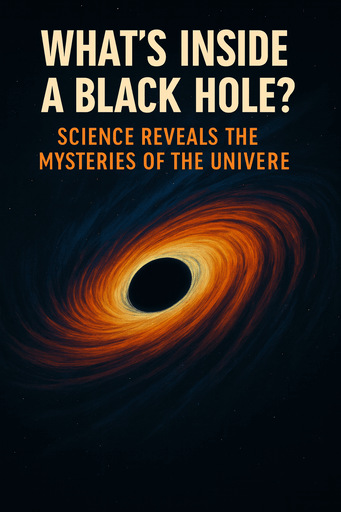🌀 A Gravity Prison Beyond Imagination
Few objects in the cosmos are as mysterious as black holes.
At the center of a black hole lies a region where gravity is so intense that not even light can escape.
We can’t observe the interior directly, but scientists have pieced together its structure using equations, gravitational-wave data, and observations from radio telescopes.
🌌 Inside the Event Horizon — A World With No Return
A black hole’s boundary is called the Event Horizon.
Once something crosses this threshold, the concepts of time and space become distorted beyond recognition, and no signal can escape back to the outside universe.
According to general relativity, all matter that falls in is compressed toward the center into a singularity — a point of seemingly infinite density where the known laws of physics collapse.
⚛️ The Singularity — Is “Infinite Density” Real?
But does infinite density truly exist?
When quantum mechanics is taken into account, the story becomes far more complex.
General relativity governs the large-scale universe, while quantum gravity attempts to describe the ultra-small world at the Planck scale.
Some theories suggest that the singularity may not be a mathematical point at all, but rather a fluctuating quantum foam — an extremely compressed, exotic quantum state of matter and energy.
In other words, a collapsing star’s core might not disappear into an impossibly dense point, but instead transform into a radically altered quantum structure.
🔭 New Approaches: The Holographic Principle & the Information Paradox
Ever since Stephen Hawking’s work on black hole radiation, the Black Hole Information Paradox has become one of physics’ greatest puzzles.
If information falling into a black hole is lost forever, it violates quantum theory’s rule that information must be conserved.
To resolve this, physicists proposed the Holographic Principle, which suggests that all information inside a black hole may actually be stored on its 2D event horizon surface.
This means the interior could be a kind of holographic projection, challenging our very understanding of space and reality.

The idea even hints that the entire universe might itself be a 3D “projection” of fundamental information encoded on a cosmic boundary.
🧠 The Cutting Edge: AI, JWST, and New Observations
Today, AI and quantum computing are pushing black hole research into a new era.
The James Webb Space Telescope (JWST) and the Event Horizon Telescope (EHT) are producing unprecedented images of supermassive black hole shadows and surrounding gas disks.
AI algorithms analyze vast datasets to extract patterns — mapping black hole spin rates, jet angles, and plasma temperatures.
As observations accumulate, our models of black hole interiors will become increasingly accurate.
🌠 The Evolution of Black Hole Theory: From Einstein to Quantum Gravity
The concept of black holes originated in 1915 with Einstein’s general relativity.
Karl Schwarzschild soon used Einstein’s equations to calculate a radius where light could no longer escape.
Decades later, Penrose and Hawking expanded the theory, exploring gravitational collapse, black hole evaporation, and the fate of information.
Today, physicists continue striving to unite relativity with quantum mechanics into a full theory of quantum gravity.
🚀 Conclusion — “Not Knowing” Is Where Discovery Begins
The truth is, humanity still doesn’t know exactly what lies inside a black hole.
Yet this uncertainty is precisely what drives scientific progress.
With each new theory, each new telescope, and each new insight, we inch closer to understanding the universe’s deepest secrets.
Black holes remain one of the greatest cosmic mysteries — but exploring them is science at its most inspiring.

